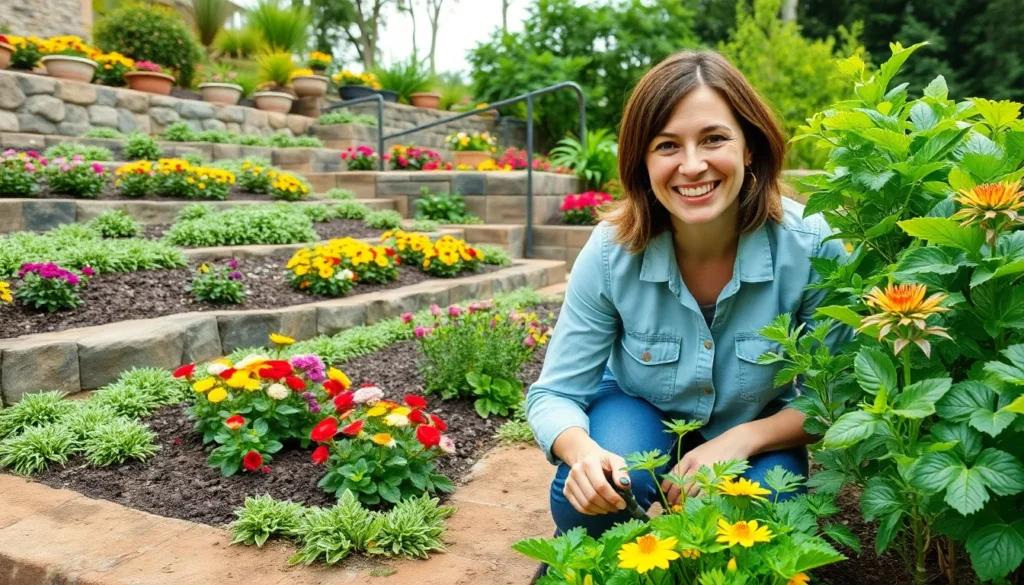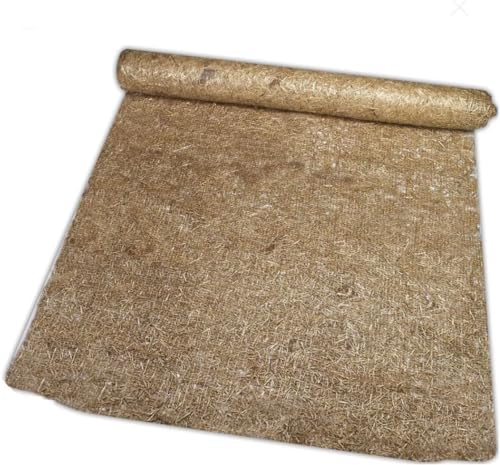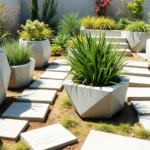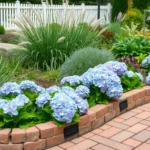Sloped gardens present unique challenges that many homeowners face but they also offer incredible opportunities to create stunning multi-level landscapes. We’ve discovered that working with natural elevation changes can transform what seems like a problematic yard into your property’s most captivating feature.
Whether you’re dealing with a gentle incline or a steep hillside we’ll show you how to turn drainage issues and erosion concerns into advantages. From terraced vegetable gardens to cascading flower beds the right slope gardening techniques can maximize your growing space while creating visual interest that flat gardens simply can’t match.
The key lies in understanding how to work with gravity rather than against it. We’ve compiled proven strategies that’ll help you design retaining walls select appropriate plants and carry out drainage answers that protect your investment while creating the garden of your dreams.
Assess Your Slope’s Unique Characteristics
Before transforming your sloped terrain into a stunning garden paradise, we need to understand what we’re working with. Every slope presents distinct challenges and opportunities that will shape our gardening approach.
Determine the Slope Grade and Drainage Patterns
Measuring your slope’s steepness helps us choose the right terracing and plant placement strategies. We can calculate the grade by measuring the vertical rise over a horizontal distance of 100 feet. Slopes under 15% work well for basic landscaping techniques, while grades between 15-30% require retaining walls or terracing. Anything steeper than 30% demands professional engineering answers.
Observing water flow patterns reveals where erosion problems might develop. Walk your slope during heavy rain to see where water naturally channels and pools. Mark these areas with flags since they’ll need special drainage answers like French drains or rain gardens. Water typically moves fastest on bare soil and slows down where existing vegetation creates natural barriers.
Installing temporary markers helps us track seasonal drainage changes. Place stakes at different elevations and observe how water behaves during spring snowmelt versus summer storms. This information guides our plant selection and hardscape placement decisions.
Analyze Soil Quality and Sun Exposure
Testing soil composition at multiple elevations shows us nutrient distribution across the slope. Upper areas often have thinner, well-draining soil while lower sections collect richer, moisture-retentive earth. We recommend taking samples every 25 feet along the slope’s length and testing for pH, nitrogen, phosphorus, and organic matter content.
Tracking sunlight patterns throughout the day reveals our best planting zones. South-facing slopes receive intense afternoon sun and require drought-tolerant plants, while north-facing areas stay cooler and support shade-loving species. Use a sun calculator app or observe shadows hourly from 8 AM to 6 PM during peak growing season.
Documenting seasonal sun changes helps us plan year-round garden success. Summer sun angles differ dramatically from winter patterns, especially on slopes. What appears sunny in July might stay shaded for months during winter, affecting plant selection for four-season interest.
Identify Existing Vegetation and Microclimates
Cataloging current plants shows us what thrives naturally in our slope conditions. Healthy native species indicate soil preferences and moisture levels that we can replicate with new plantings. Struggling plants reveal problem areas that need soil amendments or drainage improvements before we proceed with garden installation.
Mapping microclimates helps us maximize plant diversity across different slope sections. Protected alcoves stay warmer than exposed ridges, creating opportunities for tender plants in unexpected locations. Wind patterns, morning frost pockets, and reflected heat from rocks or structures all influence which plants will succeed where.
Recording wildlife activity reveals network connections we can enhance. Birds, beneficial insects, and small mammals already using your slope indicate successful habitat elements worth preserving. Their presence also suggests which plants provide food and shelter that we can incorporate into our garden design.
Create Terraced Garden Beds for Easy Maintenance
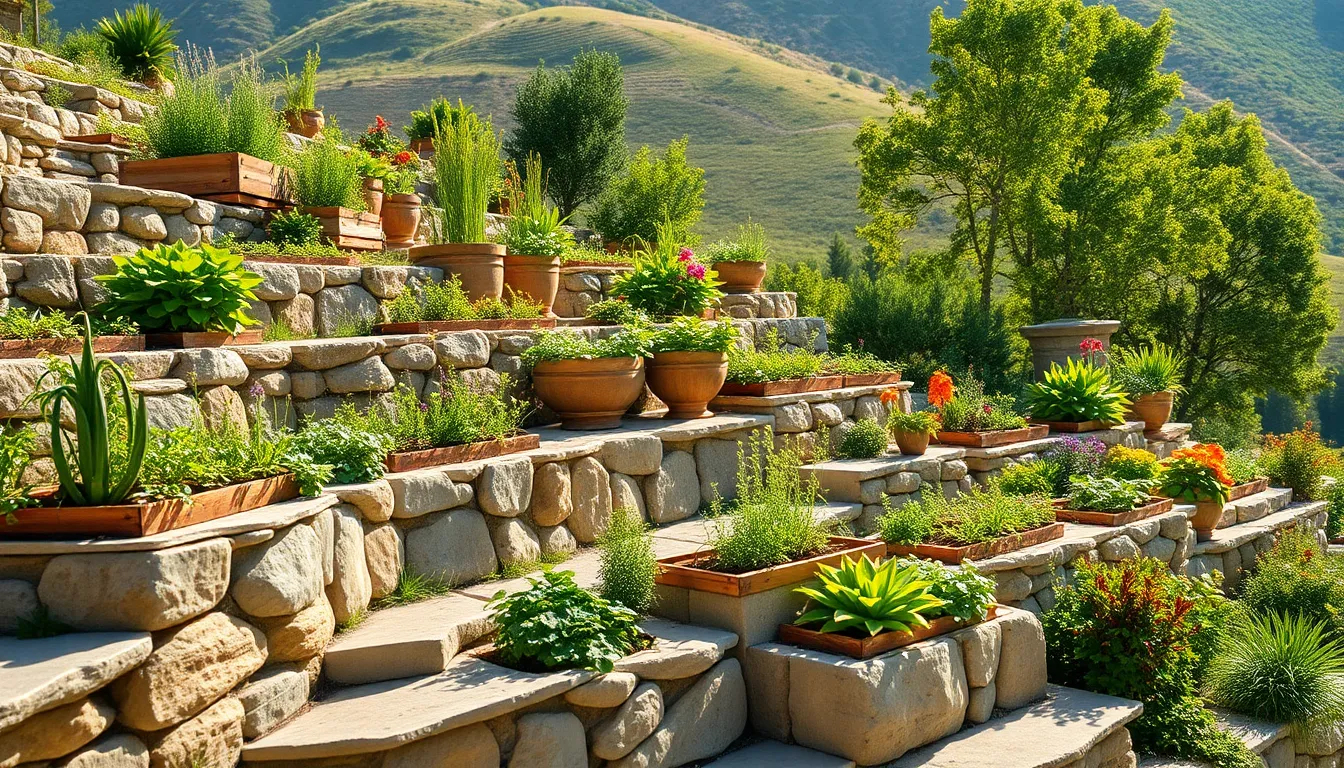
Terracing transforms challenging slopes into functional planting areas by dividing steep terrain into manageable flat sections. This approach prevents soil erosion while providing better access for garden maintenance and plant care.
Build Retaining Walls with Natural Stone
Natural stone retaining walls offer both stability and visual appeal for our terraced gardens. Stone materials like fieldstone, limestone, or granite create durable boundaries that can withstand weather and soil pressure for decades. We recommend building walls 2-4 feet high to maximize planting space while maintaining structural integrity.
Proper drainage becomes essential when constructing stone retaining walls on slopes. Installing drainage pipes behind the wall prevents water buildup that could cause structural failure. The natural texture and color variations of stone complement plantings beautifully, creating seamless transitions between hardscape and garden beds.
Construct Wooden Terraced Planters
Wooden planters provide a budget friendly alternative to stone walls while offering excellent versatility in design. Cedar, redwood, or pressure treated lumber work best for slope applications due to their weather resistance and longevity. These materials typically cost 40-60% less than natural stone installations.
Building wooden terraced planters allows us to customize dimensions based on exact slope angles and plant requirements. The planters can be constructed in modular sections, making installation easier on steep terrain. We can adjust heights from 12 inches for herbs to 36 inches for deeper rooted vegetables and perennials.
Design Multi-Level Raised Garden Beds
Multi level raised beds maximize growing space while creating stunning visual depth across sloped terrain. This design allows us to grow different plant types at various elevations, from sun loving vegetables at higher levels to shade tolerant hostas in lower sections. The tiered approach improves accessibility by reducing the need to work on steep angles.
Strategic placement of raised beds at different heights creates natural microclimates throughout our slope garden. Upper beds receive more direct sunlight and drain faster, making them ideal for Mediterranean herbs and succulents. Lower beds retain more moisture and benefit from runoff, supporting lush ferns and woodland plants that thrive in these conditions.
Install Strategic Drainage Solutions
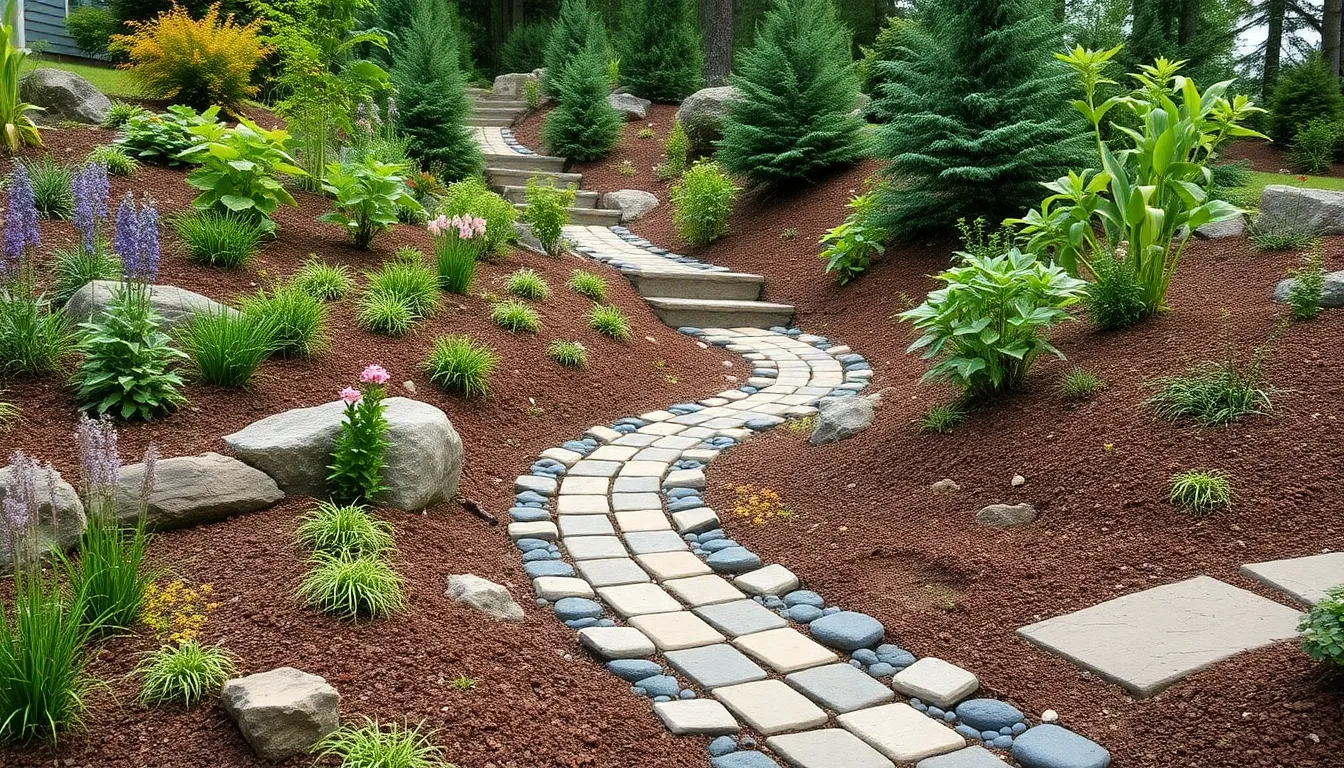
Effective water management transforms problematic slopes into thriving garden spaces while protecting your industry investment from erosion damage.
Add French Drains to Prevent Erosion
French drains redirect excess water away from your slope using a simple yet effective underground system. We install these by digging a trench along the slope’s natural water flow path and placing a perforated pipe surrounded by gravel. The gravel acts as a filter while the pipe channels water to a safe drainage area.
Installing French drains requires positioning them at the slope’s highest water collection points for maximum effectiveness. We typically place them 18 to 24 inches deep depending on your slope’s grade and soil composition. The drainage system works continuously to absorb excess moisture before it can destabilize your garden beds or wash away valuable topsoil.
Create Swales and Rain Gardens
Swales capture and filter rainwater naturally while reducing dangerous runoff on steep terrain. We design these shallow ditches to follow your slope’s natural contours and fill them with native plants that thrive in wet conditions. The plants act as living filters that clean the water while their roots stabilize the surrounding soil.
Rain gardens complement swales by creating dedicated areas for water collection and infiltration. We position these shallow depressions at the bottom of slopes where water naturally accumulates during storms. Native wildflowers and grasses planted in rain gardens create beautiful focal points while managing up to 30% more stormwater runoff than traditional lawn areas.
Build Permeable Pathways and Steps
Permeable pavers allow water to pass through hardscaped areas rather than creating additional runoff problems. We install these specialized materials for walkways and patios that need to handle foot traffic while maintaining proper drainage. The gaps between pavers let water reach the soil below while providing stable surfaces for garden access.
Strategic step placement creates multiple garden levels while incorporating natural drainage channels. We build steps using materials like natural stone or treated lumber with gaps that allow water flow between levels. Each step platform can accommodate raised beds or container gardens while the spaces between steps channel water safely down the slope.
Plant Ground Cover for Natural Erosion Control
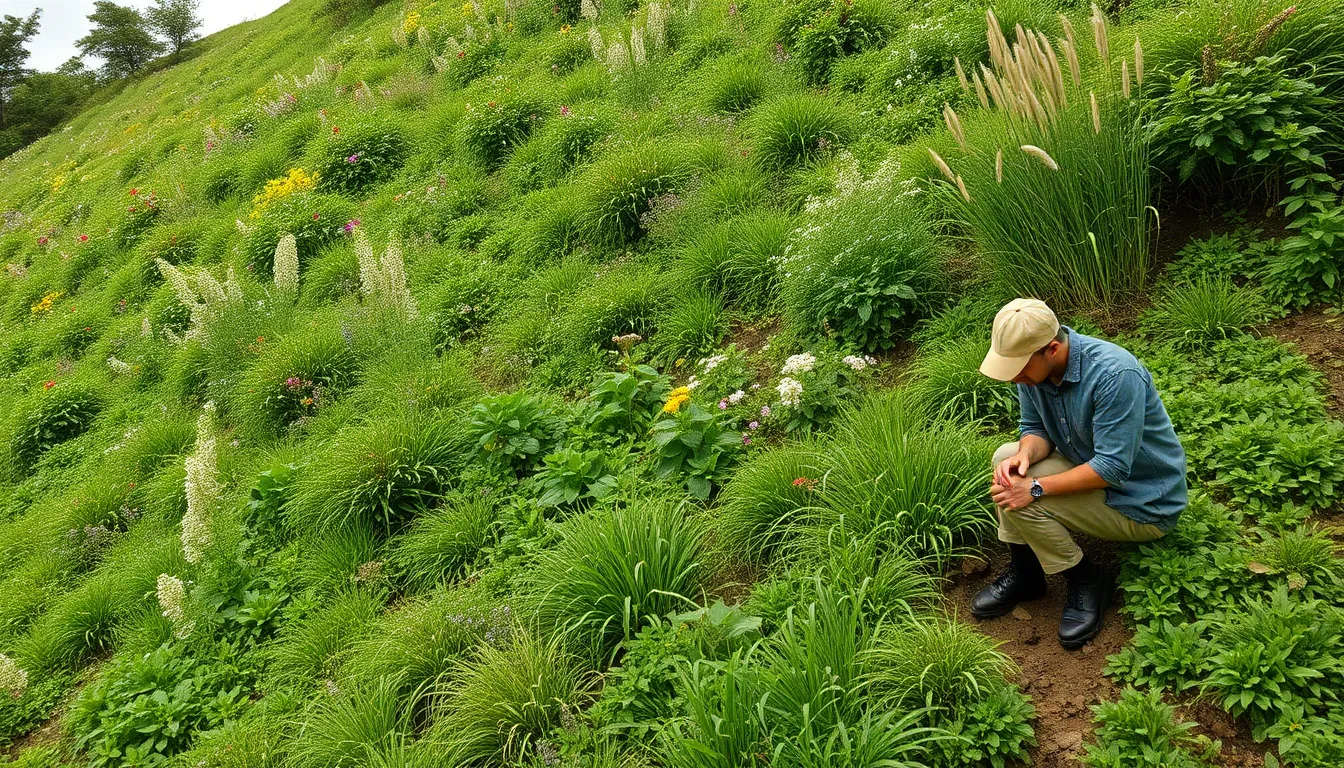
Ground cover plants offer one of nature’s most effective answers for stabilizing sloped terrain. These low-growing, spreading plants create a living carpet that holds soil in place while requiring minimal maintenance once established.
Choose Native Grasses and Wildflowers
Native grasses develop extensive root systems that naturally anchor soil on slopes. Little bluestem creates dense networks of roots that penetrate deep into the ground, making it exceptionally effective for erosion control. These grasses adapt to local climate conditions and require less water than non-native alternatives.
Wildflowers complement native grasses by adding visual appeal and additional soil stabilization. Black-eyed susans establish robust root systems that help prevent soil movement during heavy rains. Native wildflower species are naturally drought tolerant and require minimal care after the first growing season.
Steep slope seed mixes combine multiple grass and wildflower varieties specifically formulated for challenging terrain. These specialized blends thrive in poor soil conditions and provide comprehensive erosion control through diverse root structures.
Select Deep-Rooted Perennial Plants
Perennial plants with deep root systems create permanent soil stabilization that improves over time. Black-eyed susans and similar deep-rooted perennials send roots several feet into the ground, creating natural soil anchors that prevent erosion. These plants return each year stronger than before, building more extensive root networks with each growing season.
Deep-rooted perennials also improve soil structure by creating channels for water infiltration. Their root systems break up compacted soil and allow moisture to penetrate deeper rather than running off the surface.
Establish Living Mulch Systems
Living mulch creates a protective layer over soil while providing ongoing benefits throughout the growing season. Clover serves as an excellent living mulch option, spreading across the ground to suppress weeds and retain soil moisture. This approach adds organic matter to the soil as the living mulch decomposes, gradually improving soil health and fertility.
Living mulch systems reduce maintenance by eliminating the need to replace traditional mulch annually. They also provide habitat for beneficial insects and create a more natural appearance than conventional mulching materials.
Design Functional Walkways and Access Points
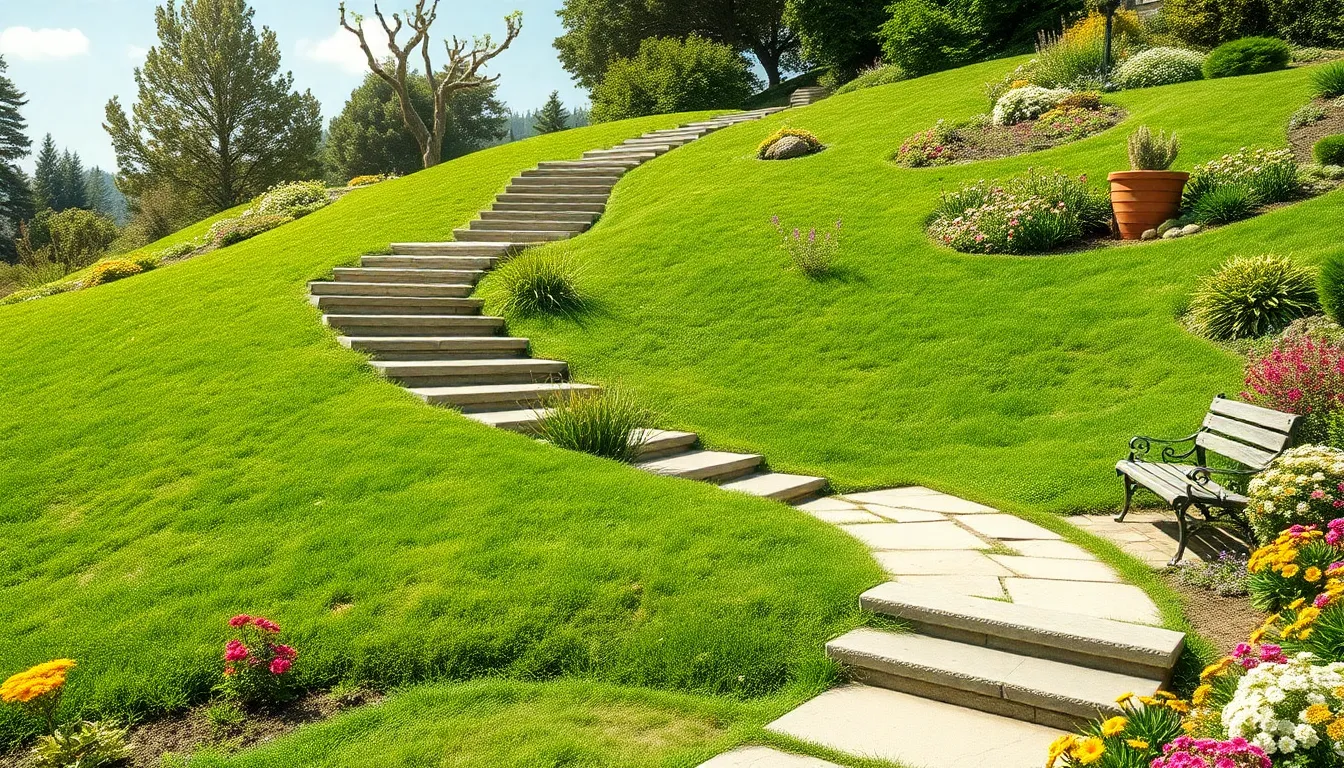
Creating accessible pathways transforms steep slopes into navigable garden spaces while maintaining safety and visual appeal. We’ll explore strategic approaches to build functional walkways that work with your slope’s natural contours.
Build Switchback Paths for Gentle Grades
Switchback design reduces slope steepness by creating zigzag patterns that make steep terrain more manageable for walking. We recommend implementing these curved pathways to follow your slope’s natural contours while adding visual interest to the overall garden design.
Stabilization becomes crucial when constructing these winding routes on sloped terrain. We suggest using rocks, gravel, or wooden planks to prevent soil erosion along pathway edges and maintain structural integrity over time.
Path width should measure at least 3 feet to accommodate comfortable walking and garden maintenance activities. We’ve found that incorporating gentle curves every 8 to 10 feet creates the most effective grade reduction while maintaining natural flow through the industry.
Install Non-Slip Steps and Handrails
Safety features become essential when handling steep garden slopes where maintaining balance presents ongoing challenges. We prioritize installing non-slip steps with textured surfaces that provide reliable traction in wet and dry conditions.
Material choice significantly impacts both functionality and aesthetic appeal in sloped garden designs. We recommend using wood, stone, or brick for step construction as these materials offer excellent traction while complementing natural garden environments.
Handrail installation provides additional stability and confidence when traversing elevated garden areas. We suggest positioning rails at 36 inches high with sturdy mounting systems that can withstand weather exposure and regular use.
Step dimensions should follow standard safety guidelines with 7-inch risers and 11-inch treads for optimal comfort. We’ve discovered that consistent spacing prevents tripping hazards while maintaining predictable navigation patterns throughout the garden.
Create Landing Areas and Rest Spots
Level landings provide essential rest areas at regular intervals along sloped pathways and step sequences. We design these flat spaces every 20 to 30 feet to offer comfortable observation points and reduce fatigue during garden navigation.
Seating areas enhance the functionality of landing spaces by creating dedicated spots for relaxation and garden enjoyment. We recommend incorporating benches or built-in seating that takes advantage of scenic viewpoints and provides comfortable resting opportunities.
Landing size should accommodate at least two people comfortably with minimum dimensions of 4 feet by 4 feet. We’ve found that larger landings measuring 6 feet by 8 feet create more versatile spaces for garden activities and social interaction.
Strategic placement of these rest areas considers both safety requirements and scenic opportunities throughout the sloped industry. We position landings to highlight garden focal points, provide shade during hot weather, and offer the best vantage points for appreciating the multi-level garden design.
Incorporate Water Features That Work with Gravity
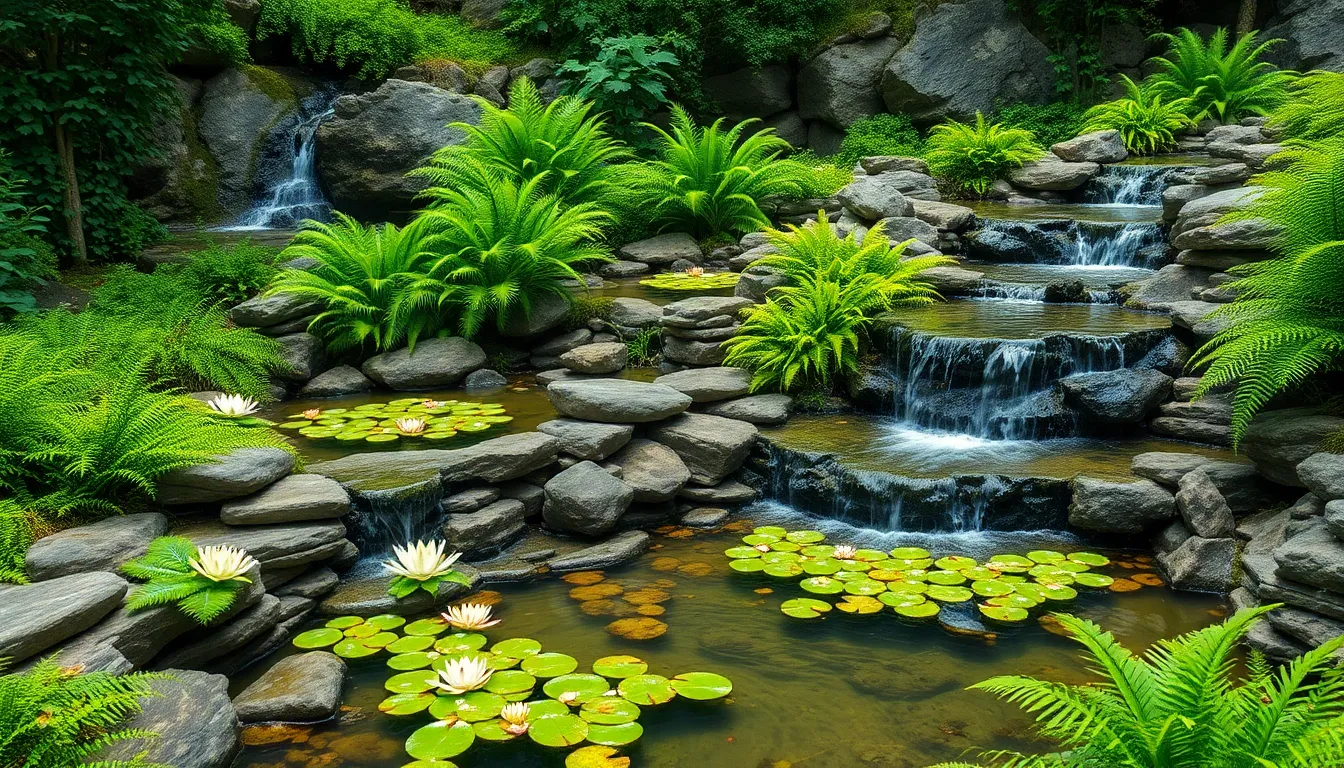
Water features transform sloped gardens into stunning landscapes while utilizing natural gravitational flow. These elements solve drainage challenges and create focal points that enhance both visual appeal and functionality.
Design Cascading Water Gardens
Cascading water gardens use tiered water features that flow from one level to another. We recommend building multiple connected pools at different elevations to create this flowing effect naturally. Stone or concrete basins work best for durability, while flexible pond liner allows for custom shapes that complement your slope’s contours.
Position the highest water source at your slope’s peak for maximum impact. Gravity pulls water through each successive tier, creating the continuous cascade effect without requiring powerful pumps. Small spillways between levels control water flow and prevent erosion around each basin.
Plant aquatic vegetation like water lilies and cattails in the pools. These plants filter the water naturally while adding color and texture to your cascade system. Surrounding each tier with moisture loving plants like hostas and ferns creates lush transitions between water levels.
Build Natural Rock Waterfalls
Natural rock waterfalls integrate seamlessly with sloped terrain using local stone materials. We suggest selecting rocks that match your area’s geological features for the most authentic appearance. Large anchor stones form the waterfall’s structure, while smaller rocks create natural looking spillways and pools.
Stack rocks to create stepped falls that work with your slope’s angle. Each rock placement should direct water flow naturally while preventing splash and erosion. Mortar between stones ensures stability, but leave gaps for water to flow through creating that natural waterfall sound.
Install proper underlayment beneath rocks to protect pond liner from punctures. Geotextile fabric cushions sharp rock edges while allowing water to flow freely. Position the liner to extend beyond visible rock edges, tucking it securely behind stones for a seamless natural appearance.
Install Hillside Stream Systems
Hillside stream systems create gentle water flow that follows your slope’s natural contours. We design these streams with meandering paths that slow water velocity and prevent erosion. Flexible stream beds allow for curves and bends that look completely natural in the industry.
Build small check dams using rocks or logs to create pools along the stream path. These features slow water flow during heavy rains while providing wildlife habitat and visual interest. Space check dams every 10 to 15 feet depending on your slope’s steepness and soil conditions.
Line stream beds with river rock and pebbles for authentic appearance and function. Smooth stones allow water to flow freely while filtering sediment naturally. Vary stone sizes from large cobbles in the stream center to fine gravel along edges for the most realistic stream bed appearance.
Select Plants That Thrive on Slopes
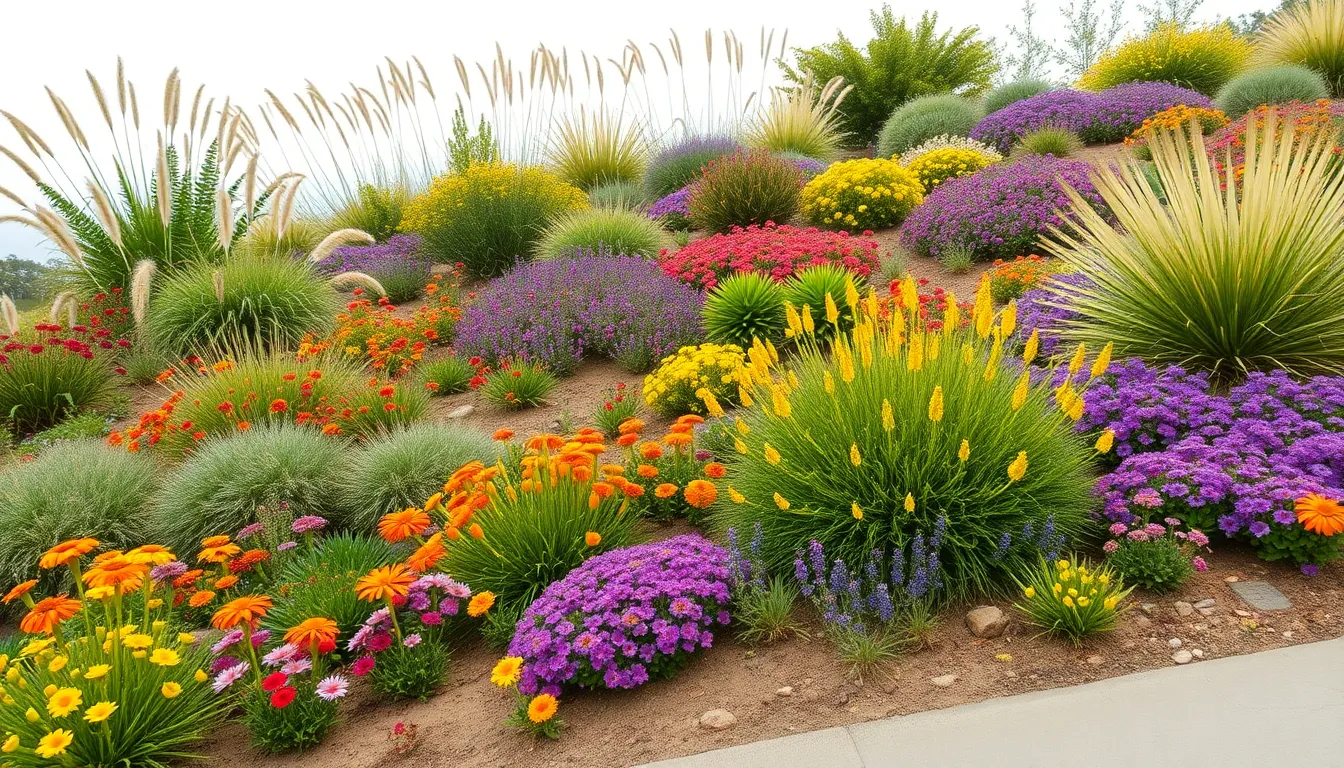
Choosing the right plants for your sloped garden creates the foundation for long-term success and natural erosion control. We’ll focus on species that not only survive but actively improve your slope’s stability and appearance.
Choose Drought-Tolerant Native Species
Native plants adapted to your region require minimal maintenance while providing maximum slope protection. Coneflower, prairie plants, and ornamental grasses establish deep root systems that anchor soil naturally and resist local weather patterns.
Drought-tolerant species like sedum, rock cress, creeping phlox, and sweet alyssum excel on slopes because they prevent soil erosion without constant watering. These plants create dense mats that slow water runoff and protect vulnerable soil from washing away during heavy rains.
Groundcovers such as juniper and yarrow form living carpets that stabilize terrain while adding year-round color. We recommend selecting species that match your exact climate zone and soil conditions for the best establishment rates and long-term performance.
Plant Trees and Shrubs for Stability
Shrubs and trees provide essential structural support by anchoring soil with their extensive root systems. Conical evergreens and rounded shrubs add vertical interest while creating windbreaks that protect smaller plants from harsh weather conditions.
Deep-rooted woody plants prevent soil erosion more effectively than shallow-rooted alternatives because their roots penetrate multiple soil layers. These established root networks create underground frameworks that hold soil particles together during storms and seasonal freeze-thaw cycles.
Strategic placement of larger plants at the top and middle sections of your slope creates natural terracing effects. We suggest spacing trees and shrubs to allow adequate light penetration while maintaining continuous root coverage throughout the slope area.
Add Colorful Flowering Plants for Visual Appeal
Flowering plants transform functional slope gardens into stunning industry features that change with the seasons. Mix different textures and colors to create ever-changing visual layers that draw the eye naturally up and down the slope.
Plants like lamb’s ear provide soft, silvery foliage that contrasts beautifully with spiky flowers and creates movement in the garden design. These textural combinations add depth and interest while maintaining the practical benefits of soil stabilization.
Seasonal bloomers ensure continuous color throughout the growing season while supporting local pollinators and wildlife. We recommend grouping plants with similar water and light requirements together to create cohesive planting zones that are easier to maintain and more visually impactful.
Maximize Vertical Growing Space
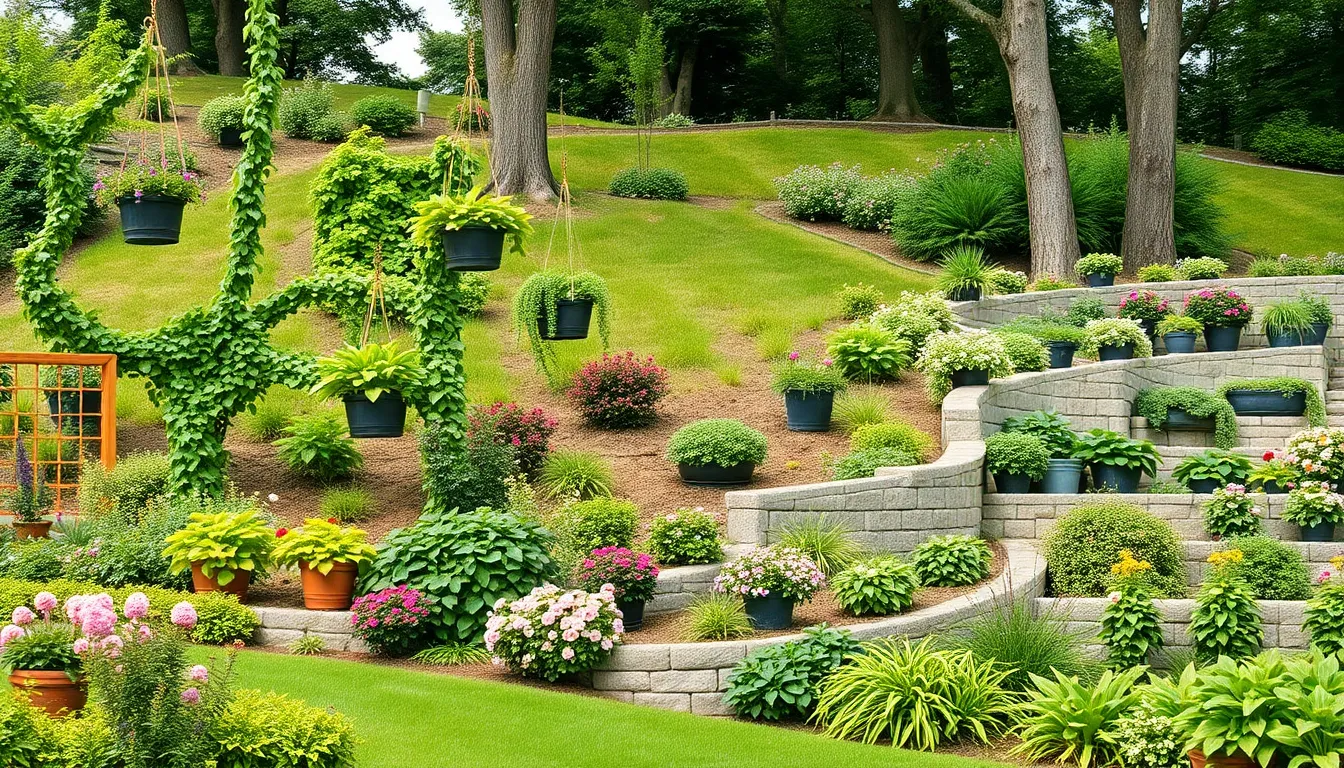
We can transform our sloped garden into a thriving vertical paradise by utilizing the natural elevation changes to create multiple layers of growing space. Strategic vertical elements work with our slope’s natural contours to maximize planting opportunities while adding structural beauty.
Install Trellises and Climbing Structures
Installing trellises creates immediate vertical growing opportunities while providing essential slope stabilization. We’ll position these structures at strategic points along our slope to support climbing plants like vines, roses, or clematis that naturally follow the terrain’s elevation changes.
Climbing structures serve dual purposes by anchoring soil and creating living walls of vegetation. Metal or wooden trellises can be secured directly into the slope using deep posts that reach stable soil levels. We recommend spacing these structures every 6-8 feet along steeper sections where soil movement poses the greatest risk.
Arbors and pergolas work exceptionally well on gentler slopes where we want to create defined garden rooms. These larger structures can support heavier climbing plants while providing shaded seating areas and visual anchors throughout our vertical garden design.
Create Hanging Garden Systems
Hanging baskets and planters add immediate visual interest while maximizing growing space on challenging slope areas. We can suspend these containers from existing trees, installed posts, or overhead structures to create floating gardens that don’t compete with ground level plantings.
Tiered hanging systems work particularly well where traditional planting becomes difficult due to steep angles or poor soil conditions. Multiple levels of suspended planters create cascading displays that follow our slope’s natural flow while providing easy maintenance access.
Strategic placement of hanging gardens helps fill empty vertical spaces between terraced areas or retaining walls. We’ll position these systems to catch morning light while avoiding areas where they might interfere with natural water drainage patterns.
Build Vertical Planting Walls
Vertical planting walls transform steep, unusable slope sections into productive growing surfaces while providing crucial soil stabilization. We can construct modular wall planters that follow our slope’s contours or build custom retaining walls with integrated planting pockets.
Modular systems offer flexibility for changing plant arrangements and seasonal displays throughout our vertical garden. These prefabricated units can be stacked and arranged to create living walls that adapt to our slope’s exact angles and drainage requirements.
Built-in planters within retaining walls provide permanent growing spaces while serving structural purposes. We’ll incorporate proper drainage systems and soil depth requirements into these walls to ensure healthy plant growth and long-term stability of our vertical garden features.
Implement Low-Maintenance Design Strategies
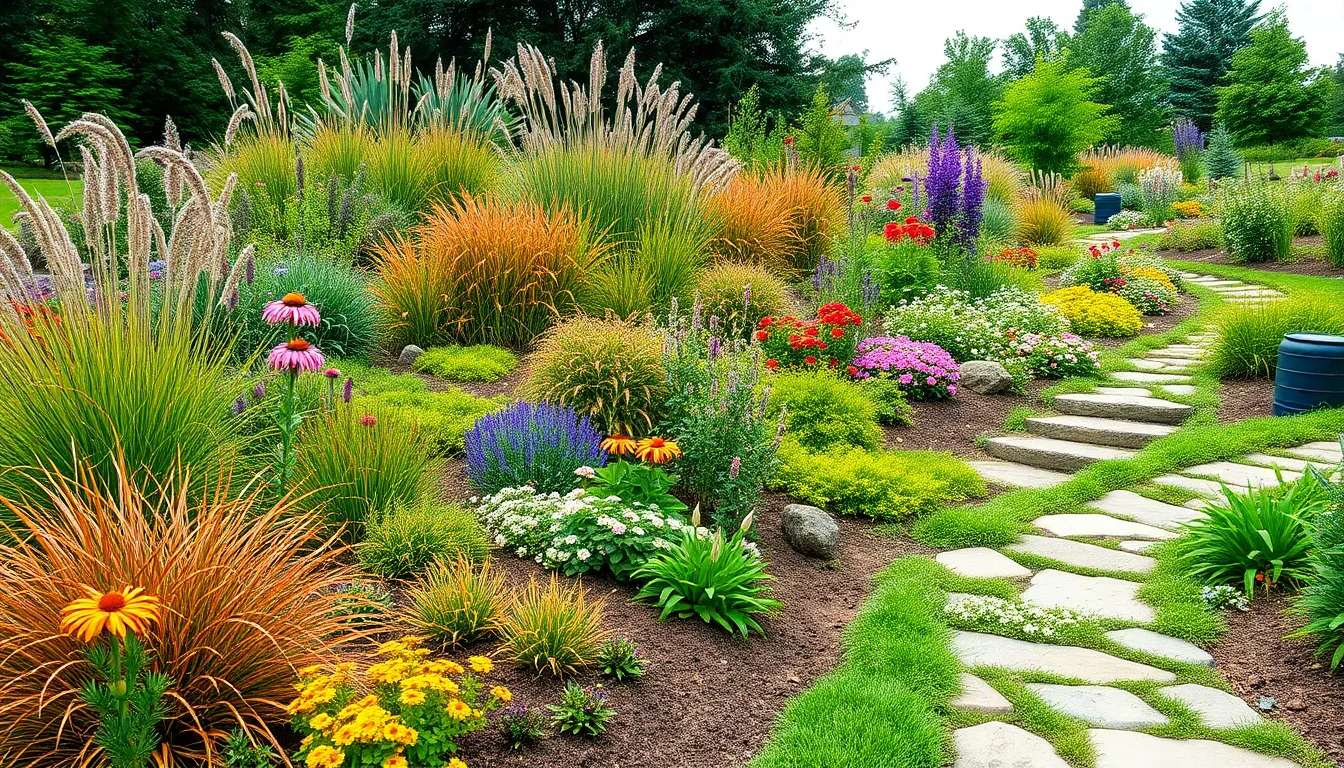
Creating a slope garden that maintains itself requires strategic planning that works with your terrain’s natural characteristics. We can transform challenging sloped areas into beautiful, functional spaces by implementing design elements that minimize ongoing maintenance while maximizing visual impact.
Use Mulching Techniques for Slope Stability
Organic mulch applications provide dual benefits of soil stabilization and moisture retention across sloped terrain. We recommend applying a 3-4 inch layer of shredded bark, wood chips, or straw to reduce water runoff by up to 60% while suppressing weed growth naturally.
Erosion control groundcovers like creeping phlox create living mulch systems that anchor soil with extensive root networks. These spreading plants form dense mats that protect against water damage while requiring minimal care once established.
Mulch placement strategies focus on high-risk erosion zones where water flow concentrates during heavy rainfall. We position organic materials in swales and around plant bases to capture sediment and gradually decompose into soil-enriching nutrients.
Design Self-Watering Systems
Rainwater harvesting systems collect natural precipitation in strategically placed containers or underground cisterns for later use. We can reduce maintenance irrigation needs by 40-70% through proper collection barrel placement at downspout locations and roof runoff areas.
Drip irrigation networks deliver water directly to plant root zones while preventing wasteful surface runoff on slopes. These systems use 30-50% less water than traditional sprinkler methods and can be automated with timers for hands-off operation.
Gravity fed watering utilizes your slope’s natural elevation to move water downhill through perforated tubing or soaker hoses. We install water sources at the highest points to create consistent, low-pressure irrigation that requires no electricity or pumps.
Choose Plants That Require Minimal Care
Ornamental grasses and shrubs provide year-round structure while requiring infrequent watering and no fertilization once established. Species like fountain grass, blue fescue, and spirea offer visual interest through multiple seasons without demanding regular maintenance schedules.
Drought tolerant groundcovers such as sedum varieties and sweet alyssum create carpet-like coverage that thrives in poor soils. These resilient plants spread naturally to fill bare spots and require pruning only once per growing season.
Native plant selections adapt to local climate conditions and support beneficial insects without requiring supplemental watering or pest control treatments. We choose species like black-eyed Susan, purple coneflower, and native bunch grasses that establish deep root systems for long-term slope stabilization.
Add Functional Outdoor Living Spaces
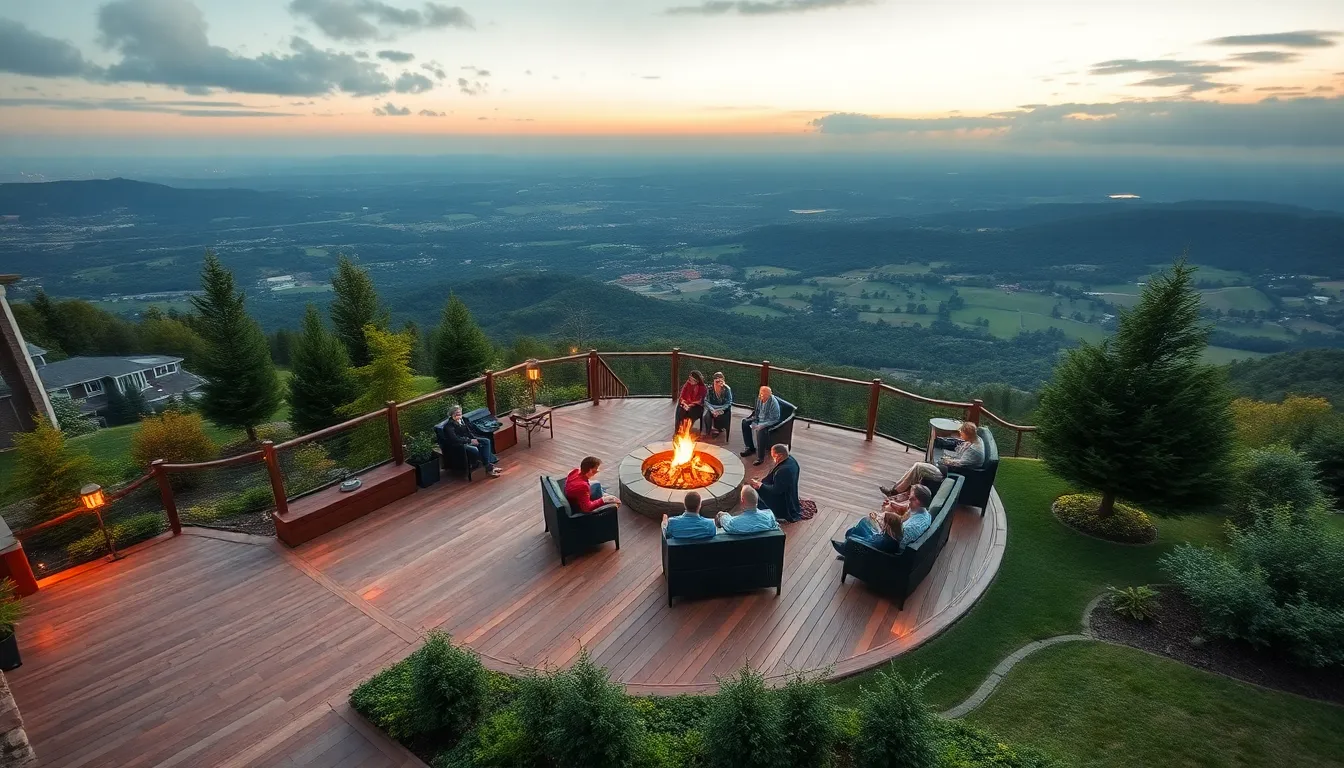
Sloped gardens offer unique opportunities to create distinct outdoor living zones that wouldn’t be possible on flat terrain. We can transform challenging elevation changes into inviting spaces that enhance both the functionality and entertainment value of our outdoor areas.
Create Level Seating Areas and Decks
Building stable seating areas on slopes requires strategic use of retaining walls to establish flat platforms for comfortable outdoor living. We recommend constructing these level zones at key viewpoints where guests can enjoy panoramic views of the garden and surrounding industry. Wooden decks work exceptionally well for moderate slopes, allowing us to bridge elevation changes while providing substantial outdoor living space.
Stone or concrete retaining walls offer the structural support needed for larger seating areas, creating permanent answers that blend naturally with the industry. We can incorporate built-in benches directly into retaining wall designs, maximizing space efficiency while providing comfortable seating options. Multi-level deck systems allow us to create cascading outdoor rooms that follow the natural contours of the slope.
Build Fire Pits and Gathering Spaces
Fire pits become natural focal points on sloped terrain, drawing people together while taking advantage of the natural amphitheater effect that slopes provide. We can excavate level areas specifically for fire features, using the excavated soil to build up other areas of the garden. Surrounding seating should follow the slope’s natural curve, creating intimate gathering spaces that feel integrated with the industry.
Safety considerations become particularly important on slopes, requiring proper clearance distances and stable footing around fire features. We recommend using stone or brick materials that complement existing retaining walls, creating visual continuity throughout the outdoor living spaces. Built-in seating walls around fire pits provide both functionality and additional soil retention.
Design Outdoor Kitchen and Dining Areas
Terraced outdoor kitchens take advantage of natural elevation changes to create distinct cooking and dining zones that feel separate from other garden areas. We can position cooking areas on upper terraces to keep smoke and cooking odors away from seating areas below. Level platforms for outdoor kitchens require substantial retaining wall construction to ensure stability for heavy appliances and frequent use.
Dining areas work best on the largest available flat spaces, often requiring important terracing investment but delivering exceptional entertaining value. We should consider sight lines from dining areas to other parts of the garden, positioning tables where diners can enjoy the best views of our sloped industry. Built-in planters can define outdoor kitchen boundaries while providing fresh herbs and vegetables within easy reach of cooking areas.
Conclusion
Transforming your sloped garden from a challenging terrain into a stunning industry doesn’t have to be overwhelming. We’ve shown you that with the right approach—from strategic terracing and drainage answers to carefully selected plants and vertical growing systems—your slope can become the most captivating feature of your outdoor space.
Remember that successful slope gardening is all about working with nature rather than against it. By embracing your garden’s natural elevation changes and implementing low-maintenance design strategies you’ll create a sustainable industry that thrives year after year.
Your sloped garden has the potential to become more than just a planting area—it’s an opportunity to create functional outdoor living spaces that maximize both beauty and usability. Start with one section and gradually expand your vision as you gain confidence in managing your unique terrain.
Frequently Asked Questions
What are the main challenges of gardening on a slope?
The primary challenges include drainage issues, soil erosion, and difficulty accessing different areas of the garden. Water tends to run off quickly, carrying away topsoil and nutrients. Additionally, steep slopes can be dangerous to navigate and may require special considerations for plant placement and garden maintenance.
How do I assess my slope before starting a garden?
Measure the slope grade and observe drainage patterns during heavy rain to identify water flow and potential erosion risks. Analyze soil quality at different elevations, track sun exposure throughout the day, and catalog existing vegetation. This assessment helps inform your terracing strategy and plant selection decisions.
What are terraced garden beds and how do they help?
Terraced garden beds are level planting areas created by building retaining walls at different elevations on a slope. They transform challenging slopes into manageable growing spaces, prevent soil erosion, maximize planting area, and create diverse microclimates for different plant types while improving garden accessibility.
What drainage solutions work best for sloped gardens?
Install French drains at high water collection points to redirect excess water away from slopes. Create swales and rain gardens to capture and filter rainwater naturally. Use permeable pathways and steps to allow water infiltration while maintaining accessibility. These solutions prevent erosion and protect your garden investment.
Which plants are best for slope stabilization?
Choose drought-tolerant native species with extensive root systems like ornamental grasses, coneflower, and prairie plants. Groundcovers such as juniper and yarrow effectively stabilize terrain. Deep-rooted perennial plants and native wildflowers provide long-term soil anchoring while requiring minimal maintenance and enhancing visual appeal.
How can I create safe walkways on steep slopes?
Build switchback paths to reduce slope steepness and use materials like rocks, gravel, or wooden planks for stabilization. Install non-slip steps with proper dimensions and add handrails for safety. Create landing areas and rest spots along pathways to provide comfortable observation points and enhance accessibility.
Can I incorporate water features into my sloped garden?
Yes, slopes are ideal for water features that work with gravity. Design cascading water gardens with tiered features, build natural rock waterfalls, or install hillside stream systems that follow the slope’s contours. Use check dams and natural stone for effective water management while adding visual interest.
How do I maximize growing space on a slope?
Utilize vertical growing techniques by installing trellises and climbing structures, creating hanging garden systems, and building vertical planting walls. These methods transform steep areas into productive growing surfaces while adding visual interest and maximizing your available planting opportunities without requiring additional ground space.
What low-maintenance strategies work best for sloped gardens?
Use organic mulch to stabilize soil and retain moisture, implement self-watering systems like rainwater harvesting and drip irrigation, and select drought-tolerant native plants that require minimal care. Choose groundcovers and perennials that naturally spread and establish themselves with little intervention once established.
Can I create outdoor living spaces on a slope?
Absolutely! Build level seating areas using retaining walls, integrate fire pits that take advantage of the natural amphitheater effect, and design outdoor dining spaces with strategic placement. Construct stable decks and patios at different elevations to create functional entertainment areas that blend seamlessly with your sloped landscape.

